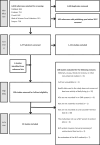Natural language processing systems for extracting information from electronic health records about activities of daily living. A systematic review
- PMID: 38798774
- PMCID: PMC11126158
- DOI: 10.1093/jamiaopen/ooae044
Natural language processing systems for extracting information from electronic health records about activities of daily living. A systematic review
Abstract
Objective: Natural language processing (NLP) can enhance research on activities of daily living (ADL) by extracting structured information from unstructured electronic health records (EHRs) notes. This review aims to give insight into the state-of-the-art, usability, and performance of NLP systems to extract information on ADL from EHRs.
Materials and methods: A systematic review was conducted based on searches in Pubmed, Embase, Cinahl, Web of Science, and Scopus. Studies published between 2017 and 2022 were selected based on predefined eligibility criteria.
Results: The review identified 22 studies. Most studies (65%) used NLP for classifying unstructured EHR data on 1 or 2 ADL. Deep learning, combined with a ruled-based method or machine learning, was the approach most commonly used. NLP systems varied widely in terms of the pre-processing and algorithms. Common performance evaluation methods were cross-validation and train/test datasets, with F1, precision, and sensitivity as the most frequently reported evaluation metrics. Most studies reported relativity high overall scores on the evaluation metrics.
Discussion: NLP systems are valuable for the extraction of unstructured EHR data on ADL. However, comparing the performance of NLP systems is difficult due to the diversity of the studies and challenges related to the dataset, including restricted access to EHR data, inadequate documentation, lack of granularity, and small datasets.
Conclusion: This systematic review indicates that NLP is promising for deriving information on ADL from unstructured EHR notes. However, what the best-performing NLP system is, depends on characteristics of the dataset, research question, and type of ADL.
Keywords: activities of daily living; electronic health records; free-text notes; natural language processing; unstructured data.
© The Author(s) 2024. Published by Oxford University Press on behalf of the American Medical Informatics Association.
Conflict of interest statement
None declared.
Figures
Similar articles
-
Natural language processing with machine learning methods to analyze unstructured patient-reported outcomes derived from electronic health records: A systematic review.Artif Intell Med. 2023 Dec;146:102701. doi: 10.1016/j.artmed.2023.102701. Epub 2023 Nov 1. Artif Intell Med. 2023. PMID: 38042599 Free PMC article.
-
Leveraging Natural Language Processing and Machine Learning Methods for Adverse Drug Event Detection in Electronic Health/Medical Records: A Scoping Review.Drug Saf. 2025 Apr;48(4):321-337. doi: 10.1007/s40264-024-01505-6. Epub 2025 Jan 9. Drug Saf. 2025. PMID: 39786481 Free PMC article.
-
Natural language processing of symptoms documented in free-text narratives of electronic health records: a systematic review.J Am Med Inform Assoc. 2019 Apr 1;26(4):364-379. doi: 10.1093/jamia/ocy173. J Am Med Inform Assoc. 2019. PMID: 30726935 Free PMC article.
-
Identifying Patient-Reported Outcome Measure Documentation in Veterans Health Administration Chiropractic Clinic Notes: Natural Language Processing Analysis.JMIR Med Inform. 2025 Apr 2;13:e66466. doi: 10.2196/66466. JMIR Med Inform. 2025. PMID: 40173367 Free PMC article.
-
Natural Language Processing of Clinical Notes on Chronic Diseases: Systematic Review.JMIR Med Inform. 2019 Apr 27;7(2):e12239. doi: 10.2196/12239. JMIR Med Inform. 2019. PMID: 31066697 Free PMC article. Review.
Cited by
-
Applying NLP methods to code functional performance in electronic health records using the international classification of functioning, disability, and health.Disabil Health J. 2025 May 24:101888. doi: 10.1016/j.dhjo.2025.101888. Online ahead of print. Disabil Health J. 2025. PMID: 40442018
-
Bibliometric analysis of artificial intelligence in healthcare research: Trends and future directions.Future Healthc J. 2024 Sep 3;11(3):100182. doi: 10.1016/j.fhj.2024.100182. eCollection 2024 Sep. Future Healthc J. 2024. PMID: 39310219 Free PMC article.
-
Qualitative changes in clinical records after implementation of pharmacist-led antimicrobial stewardship program: a text mining analysis.J Pharm Health Care Sci. 2025 Apr 23;11(1):34. doi: 10.1186/s40780-025-00439-0. J Pharm Health Care Sci. 2025. PMID: 40270013 Free PMC article.
-
From manual clinical criteria to machine learning algorithms: Comparing outcome endpoints derived from diverse electronic health record data modalities.PLOS Digit Health. 2025 May 14;4(5):e0000755. doi: 10.1371/journal.pdig.0000755. eCollection 2025 May. PLOS Digit Health. 2025. PMID: 40367064 Free PMC article.
-
Global Research Trends, Hotspots, Impacts, and Emergence of Artificial Intelligence and Machine Learning in Health and Medicine: A 25-Year Bibliometric Analysis.Healthcare (Basel). 2025 Apr 13;13(8):892. doi: 10.3390/healthcare13080892. Healthcare (Basel). 2025. PMID: 40281841 Free PMC article. Review.
References
Publication types
LinkOut - more resources
Full Text Sources

